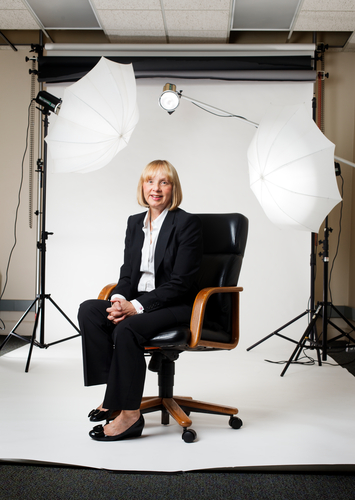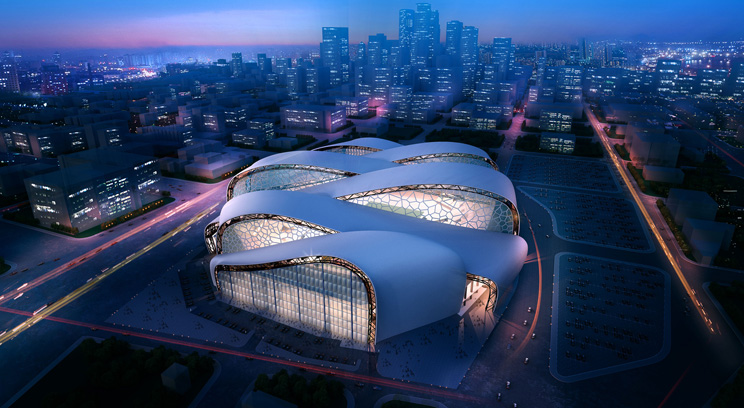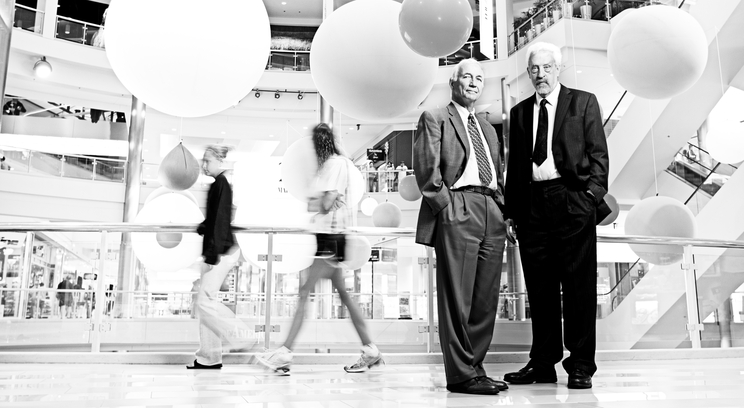What are your responsibilities as chair and the only full-time member of the Minnesota Sports Facility Authority?
As chair, I primarily run the meetings of the authority. We meet every three weeks. We’re responsible for all contracts and for managing the process of constructing and operating the building. In all key design and construction decisions, the authority and the Vikings have joint sign-off, so I need to build consensus. The city of Minneapolis is also a major player. It has an implementation committee that is advisory on all exterior elements. There are three subcommittees: design, planning and stakeholder experience, which deals with how the stadium fits in with the neighborhood and which considers issues such as parking and transportation.
I work with outside groups, so I’m a representative to the city, to the downtown business committee, to the general public. I’m a communicator who has to relay how the project is progressing. I do lots of listening and attend public meetings to hear reactions to plans. This is a statewide facility. People from all over the state are interested in it.
The big difference between this facility and the Twins stadium is that this is being built as a multipurpose facility. The Vikings only have 10 games a year here, and the facility will operate 365 days a year. The public uses the Metrodome a lot: the Gophers baseball team uses it, it’s used for motocross, it’s used for state high school leagues. My job is to build a people’s stadium. The Vikings will make sure it’s done to their specifications and to meet NFL guidelines. In general, the MSFA needs to make sure the building is done on time and under budget.

Michele Kelm-Helgen '83 (Photo by Mark Brown)
You chaired a committee that oversaw school boundary changes in eastern Carver County. How does your experience handling a very emotional transition like that help you in your current role?
When I was in the East Carver County School District, I started out chairing the boundary committee and later served for eight years as the school board chair. During that time, we built three elementary schools, a middle school, a high school addition and around the time I left we were starting a new high school. All of those building projects changed boundaries. It became apparent that the most important thing was to make sure the process was open and transparent. It was important that people felt they had the opportunity to be heard and had a chance to react. You’ll never make 100 percent of the people happy, but if those who disagree with the decision feel the process was fair, that they had the opportunity to be heard, and that they knew about things ahead of time, it makes the decision more palatable.
Process is important today with the neighborhood and business community. This is a really big project with lots of public money. There’s lots of private money, too, but it uses a lot of public money. People want to know what’s happening.
During the short time the MSFA has existed, what conflicts have you faced, and what conflicts do you think you’ll face in the upcoming years?
So far, major decisions have been made, but I haven’t experienced a great deal of conflict. The work with the Vikings has been smooth. There will be differences among the team, the public, and city and neighborhood interests. We have processes in place to find ways to reach consensus. The city committee and subcommittees will be key to interactions with the neighbor-hood.
The MSFA is charged with building a "people’s stadium" that will be located in Minneapolis and heavily used by the Vikings. How do you balance the interests of the state, the Vikings and the city of Minneapolis?
In part, the legislation gave us a good guidepost. It designated a budget, a basic program and what’s to be included in the stadium. It specified that operations are to be done by the authority. Those specifications have already balanced these different interests. In addition, Minneapolis appoints two members to the authority, and the governor appoints three, including the chair. This gives people a voice. Some key decisions, such as decisions about the exterior of the building, require four-fifths of the authority to agree on the decision, so at least one city member has to agree with the rest of the committee. This requires joint decision making. There are also minimum design standards in place. Decisions about the architect, the construction company and the space need to be agreed to by the Vikings and the authority. The governor looked to me, because, for much of my career – when I served on the school board, as chief of staff for the Minnesota Senate and as deputy chief of staff – I was a negotiator, responsible for reaching collaborative decisions. This is kind of a microcosm of that. Overall, things have been set up with a balance of power.
You have a strong background in business and politics, but this seems to be your first venture into sports. How do you chair the MSFA as an outsider to the world of sports?
Like most Minnesotans, I have been a Vikings fan, but the extent of my involvement in sports has been as a fan. I’ve never worked in the sport arena. I have had a lot of involvement with budgets and construction. I oversaw more than $100 million in construction when I was chair of the school board. As chief of staff for the Minnesota Senate, I was involved with policy and budget decisions, and as deputy chief of staff I was putting together a $34 billion state budget. I was involved in the stadium legislation itself. I also have an M.B.A. from St. Thomas. The governor was mostly interested in my financial background and my experience with budgets, including my ability to understand them and read a large spreadsheet. The Vikings will make sure the sports side is covered. Our job is to make sure that public resources are protected and public events are provided for – all the things the public has come to expect from the Metrodome.
The new stadium has myriad issues related to it, ranging from major questions, such as who will have naming rights and whether it will have a retractable roof, to details, such as acoustics and whether fan noise will make it hard for players to hear each other or their coaches. What issue has been the most surprising to you so far?
The issue that surprised me most is the retractable roof. The way the legislation was done, this was never included in the budget. The language said that if there were savings they would be used on a "retractable feature." This has been interpreted by the public as "We’ll have costs savings and a retractable roof." I’m surprised and concerned. A retractable roof costs around $180 million. I hope for a retractable feature, but the budget is $975 million. I don’t see how we can have a retractable roof. Maybe a retractable wall or window or skylight system, but not a full-blown roof like at Lucas Oil in Indianapolis. There is little likelihood that there will be that kind of savings. I’m surprised people picked up on that, and I worry that people are expecting it. Expectations are important. Usually when I explain the situation, people get it.
How will you celebrate a successful stadium opening in 2016?
I haven’t thought of that. Hopefully the public will see this as a thing to be proud of. This site, which has never really attracted development, has to become part of the neighborhood. The stadium’s exterior is important, because it connects the stadium to downtown. It can’t be an island or a barrier. People will measure success by [how well the stadium becomes a part of the neighborhood], and we’d celebrate that.
Anything else you would like to mention?
There’s one more thing I’d like to note: St. Thomas clearly is a major presence in downtown. It has done a great deal to revitalize the area that it’s in. I would see that as the kind of thing we want to do, to become part of the community. I see this as an opportunity for St. Thomas to be involved, for students and programs to have a connection. I’d appreciate its input. I think about key areas of the city and what’s made a difference. I’ve thought about St. Thomas and how we could learn from it.
Read more from B. Magazine.







